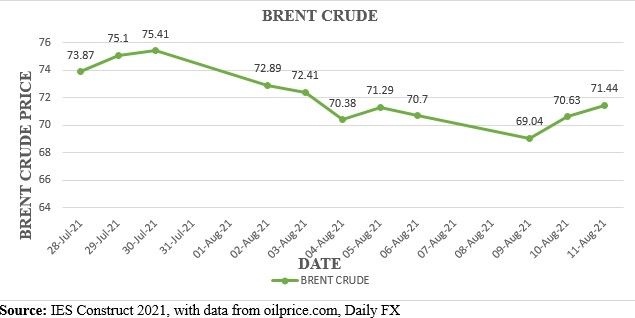Fuel prices to reduce in second half of August, IES predicts
The Institute for Energy Security (IES) foresees fuel price reduction at the pumps in the second pricing window of August 2021.
The energy think tank believes there would be a marginal reduction attributed to a drop in prices on the international market.
In a statement on Sunday, August 15, it said, “for this window, with the 1.49% reduction in the price of the International Benchmark- Brent Crude, the 2.17% decrease in the price of Gasoline, the 1.77% decrease in Gas oil price and the marginal depreciation of 0.17% of the local currency against the US dollar”, price of fuel on the domestic market at the various pumps will dip entering into the second pricing window of August.
In its 15-day rolling basis of monitoring, IES observed that the price of fuel on the Ghanaian market remained stable within the window under assessment.
Thus, the prices of petroleum products within the first pricing window of August 2021 saw the Oil Marketing Companies (OMCs) continue to maintain prices at the pump from the first pricing window of July.
The current national average price of fuel per litre at the pump remained at Gh¢5.97 for both Gasoline and Gas oil because of the relative price stability.
This pricing window also saw Zen Petroleum, Benab Oil, Cash Oil, Goodness Oil, Top Oil, and Frimps Oil recorded as the OMCs that sold the least-priced fuel according to the IES Market-Scan.

World oil market prices
On the world front, the international benchmark for Ghana, Brent Crude, saw its price on average terms selling at about $72.10 per barrel, representing a 1.49% decrease from the previous window’s average price of US$73.19 per barrel mark.
The price of the Brent Crude suffered the usual volatilities sourced from the constant geopolitical issues and the spread of the Delta variant of the COVID-19, IES explained.
It noted that the prices dipped in these windows in response to fears that the rising COVID-19 cases, spearheaded by the Delta variant, would affect demand for oil and its products.
“The rise in cases has been fuelled almost entirely by the Delta Variant of the virus and the new Delta Plus variant, both of which have highly contagious infection rates,” the statement noted.
China’s condition, a source of concern
The place of concern was largely China, which is the world’s largest importer of oil, where cases continued to rise amid the Delta Variant spread from its shores.
The prices bounced back as the market seemed to shrug off the fears of the lockdowns in China and other parts of Asia. The rise in demand across the Atlantic outweighed the impact of the COVID restrictions.
READ ALSO: Delta Variant Spread, A Big Blow To Oil Demand Outlook – IEA Predicts
The increase was also boosted by the passage of the US$1.2 trillion infrastructure bill in the US Senate, which is assumed will increase demand for oil products and improve the economic performance of the US in the short-to-mid-term, providing the much-needed support for prices.
The rebound in fuel demand in India following the lifting of restrictions on New Delhi in July, the highest since April this year also incentivized the market’s hope of a rebound in demand for oil products.
In June-July, the country’s crude oil imports dropped to an average of the 2014-2015 levels of 3.5 million barrels per day (mbpd) but saw a leap in the July-August loading of 4.2 mbpd on the back of the demand recovery.
The refined products, Gasoline and Gas oil prices as monitored on Standard and Poor’s global Platts platform show that the price of the two international commodities experienced marginal dips within the period.
For Gasoline there was a decrease in price by about 2.17% to close the window at US$726.15 per metric tonne from an earlier price of US$742.25 per metric tonne.
For Gasoil, the price saw a marginal decrease of US1.77% to close trading at US$588.67 per metric tonne from the earlier window’s price of US$599.25 per metric tonne.



